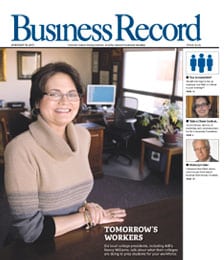Going intermodal

With the number of people working in downtown Des Moines projected to double within the next 25 years, planning now for a coordinated ground transportation hub to get all those people to work makes a lot of sense, says Tom Kane, executive director of the Des Moines Metropolitan Planning Organization.
About six months ago, the MPO began bringing together a number of transportation agencies for regular meetings to discuss the possibility of a downtown intermodal transit facility that would accommodate buses, taxis, commuter parking and even light rail in the future, Kane said.
“What we’re trying to get these agencies to do is to sit down and get a solution that’s agreeable to all the groups,” he said. “At this point, we don’t have a lot of answers; we just have a lot of questions.” The group is next scheduled to meet on July 13.
One of the more immediate concerns, according to Des Moines Metropolitan Transit Authority officials, is finding a new transfer point for city buses that would free the Walnut Street Transit Mall for other vehicle or pedestrian uses. The one-way downtown street has been reserved for weekday bus traffic only since 1984.
At the same time, the intercity bus companies that serve Des Moines — Greyhound Lines Inc., Jefferson Lines and Burlington Trailways — are investigating moving from their current depot at 12th Street and Keosauqua Way and are in discussions about being part of an intermodal transit facility.
Another consideration officials are keeping their eye on is how how light rail or other rapid-transit options, such as dedicated bus lanes along railroad right-of-ways, may eventually fit into such an all-in-one facility.
From the MTA’s perspective, keeping the city bus transfers within the core downtown area — generally between Cherry and High streets and Fifth Avenue and Ninth Street — makes the most sense for riders’ convenience, said Steve Spade, the MTA’s general manager. About 70 percent of MTA riders travel to the core downtown area.
Based on preliminary work already completed for the MTA and the city by a consultant, a bus transfer hub and an intermodal transit facility would need to be separately located to meet the distinct requirements of each, he said.
“Having a transfer facility outside that catchment area would cause a significant increase in our operating costs, because you would have to have every route go to that facility,” Spade said. However, riders who would want to get to an intermodal facility from the MTA hub could do so by using shuttles, he said.
The MTA’s vision for a new transit hub calls for an off-street structure that up to 16 buses could pull up to at one time to transfer passengers, rather than using an on-street location, Spade said. Locating a downtown site to replace the Walnut Street Transit Mall has been problematic, however. Of 13 sites initially identified by the consultant as possibilities, most of them either existing parking garages that could be torn down and rebuilt or vacant land, nearly all have been eliminated as non-workable because they would conflict with existing or planned uses, he said.
Spade said the MTA will continue to work with the consultant to develop a more detailed analysis of the potential sites.
Greyhound, which already operates from intermodal transit facilities in more than 100 cities across the country, has several more projects in the works, said Kim Plaskett, a spokeswoman at the company’s Dallas, Texas, headquarters.
For Des Moines, “we would look at how it would benefit our customers in addition to local residents,” she said. “There’s just a lot of discussion on whether such a transportation center would work. There’s a number of steps; it’s a process that can go on for several years.”
In Cedar Rapids, where that city recently opened an intermodal transit facility, Greyhound and other carriers have the advantage of being in the middle of downtown next to the science center and other attractions, “so it makes it attractive for customers that are visiting the city,” Plaskett said.
“In most of our locations in which we’re in an intermodal, it’s a facility owned by the city, and Greyhound and other tenants lease space. But we are generally very active in the process from the beginning about layout and design and what would work best for our customers,” she said.
The overall goal for an intermodal facility, Kane said, “is to give the traveler a variety of options for getting in and out of downtown.”
Building such a transportation nexus “is not pie in the sky,” he added. “It’s being done in many other locations.” In addition to Cedar Rapids, other Iowa cities that have built intermodal facilities include Sioux City and the Quad Cities.
Kane said federal transportation legislation will include funding for these type of intermodal facilities, so it’s important for Des Moines to begin the process of considering whether it’s the type of facility it will need in the future.
“I think this is a critical point for (deciding) whether some of these options will be available for Des Moines in the future,” Kane said.







